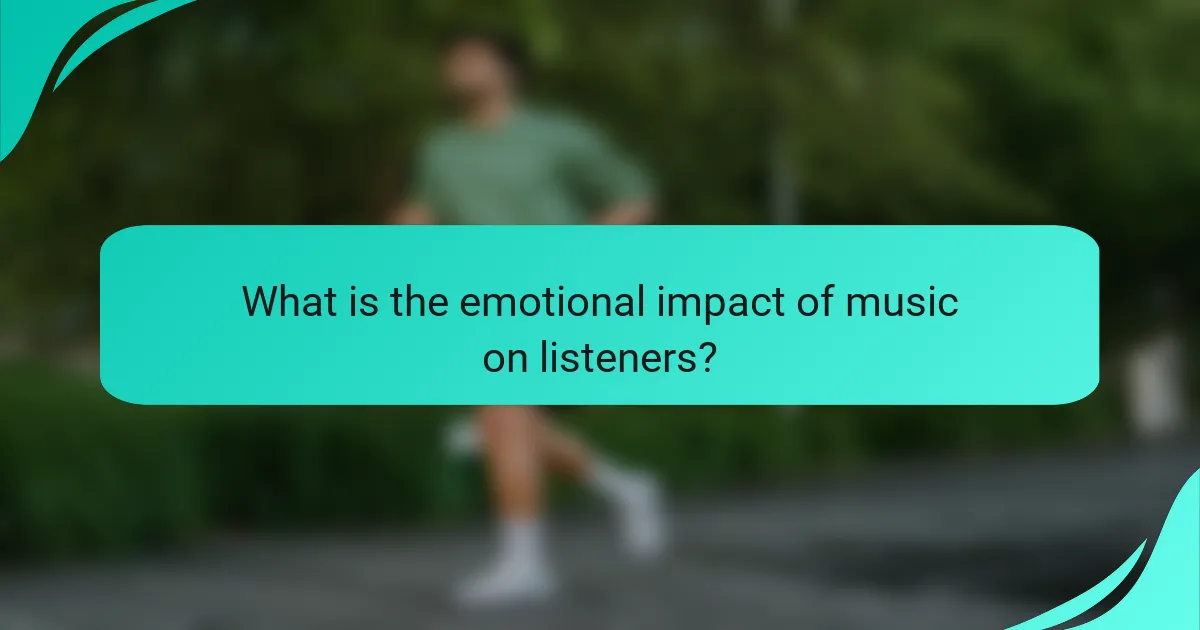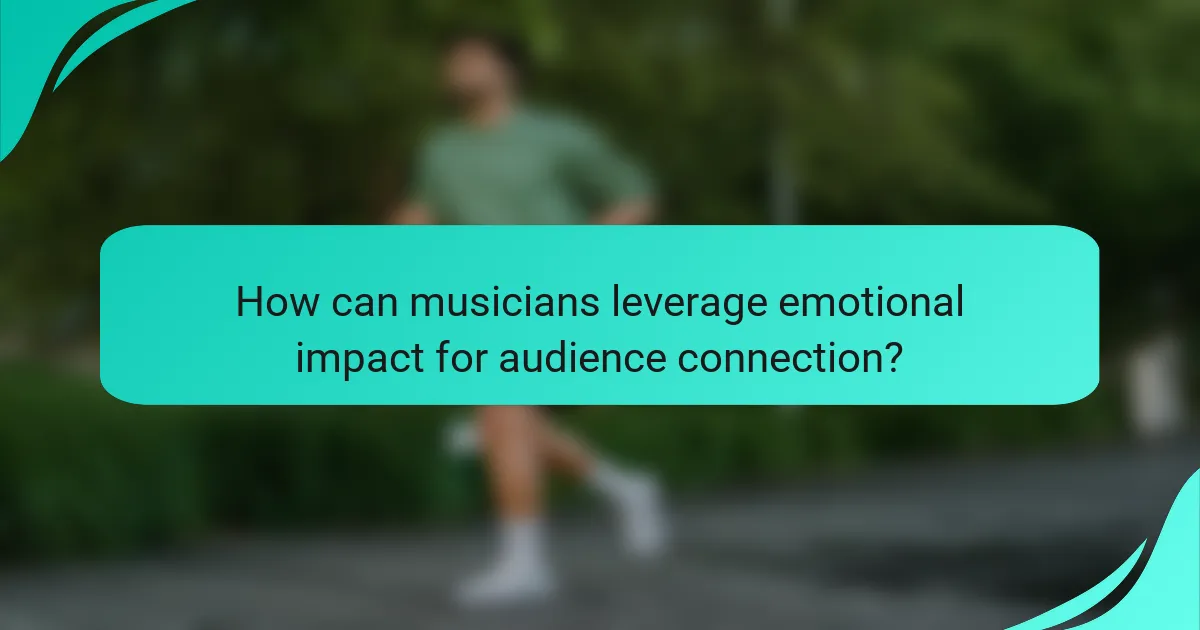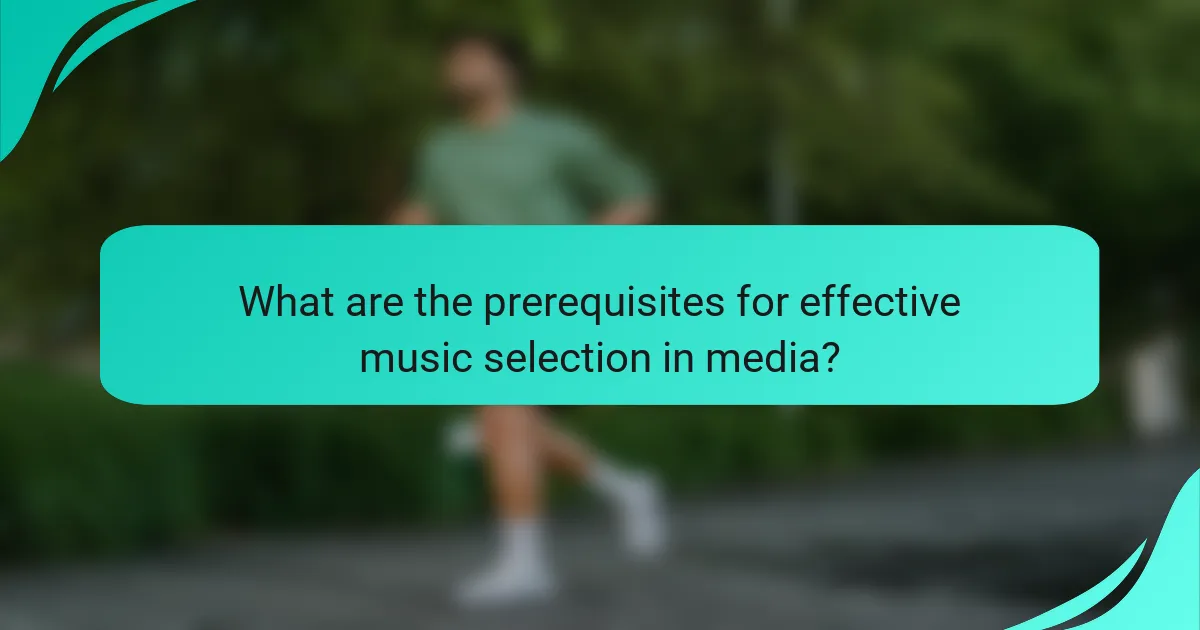Music plays a crucial role in shaping the emotional landscape of narratives, particularly in film, where it guides audience reactions and enhances their connection to the story. Its profound emotional impact can evoke specific feelings, influence mood, and foster a sense of belonging during live performances, creating an immersive experience that resonates deeply with listeners. Through rhythm, melody, and lyrics, music serves as a powerful tool for expression and connection, enriching the overall experience for audiences.

How does music set the tone in films?
Music sets the tone in films by establishing the emotional landscape and guiding audience reactions throughout the narrative. It influences how viewers interpret scenes, enhancing their overall experience and connection to the story.
Creates emotional atmosphere
Music plays a crucial role in creating an emotional atmosphere by evoking specific feelings that align with the film’s themes. For instance, a slow, melancholic score can amplify sadness during a dramatic moment, while an upbeat tempo can enhance feelings of joy or excitement. This emotional layering helps to immerse the audience in the film’s world.
Consider the use of minor keys for tension and suspense, contrasting with major keys for uplifting scenes. Filmmakers often select musical pieces that resonate with the intended emotional response, ensuring that the audience feels the desired impact.
Influences audience perception
The way music is used can significantly influence audience perception of characters and events. A character introduced with ominous music may be perceived as a villain, while a cheerful melody can create a sense of warmth and friendliness. This auditory cue shapes how viewers interpret actions and motivations.
Filmmakers can manipulate audience expectations through music, using motifs or themes associated with specific characters. For example, the recurring theme of a hero can evoke feelings of hope and resilience, guiding the audience’s emotional journey throughout the film.
Enhances storytelling
Music enhances storytelling by providing context and depth to the narrative. It can signal transitions between scenes, highlight key moments, or foreshadow events, making the story more cohesive and engaging. For example, a crescendo can indicate an impending climax, preparing the audience for a pivotal moment.
Additionally, soundtracks often reflect cultural or historical contexts, adding layers of meaning to the story. A film set in the 1980s might feature music from that era, helping to ground the narrative in its time period and resonate with viewers’ memories and experiences.

What is the emotional impact of music on listeners?
The emotional impact of music on listeners is profound, influencing feelings and thoughts in various ways. Music can evoke specific emotions, enhance memory recall, and influence mood and behavior, making it a powerful tool for connection and expression.
Triggers specific emotions
Music has the ability to trigger a wide range of emotions, from joy and excitement to sadness and nostalgia. For instance, a fast-paced, upbeat song can create feelings of happiness, while a slow, melancholic piece may evoke sadness or reflection. This emotional response is often linked to the tempo, key, and lyrics of the music.
Listeners often associate certain songs with personal experiences, further intensifying the emotional impact. For example, a song played during a significant life event can bring back memories and feelings associated with that moment, demonstrating music’s unique role in emotional recall.
Enhances memory recall
Music enhances memory recall by creating strong associations between melodies and memories. Studies suggest that music can improve the retention of information, making it easier to remember facts or experiences when paired with a specific tune. This is particularly useful in educational settings, where songs can aid in learning and retention.
For example, children often learn the alphabet through catchy songs, which makes the information more memorable. Similarly, adults may find that listening to music from their youth helps them recall specific events or details from that time.
Influences mood and behavior
Music significantly influences mood and behavior, often serving as a catalyst for emotional change. Upbeat music can energize listeners, encouraging physical activity or social interaction, while calming music can promote relaxation and reduce stress. This is why many people create playlists tailored to their desired mood or activity.
Moreover, music therapy is increasingly recognized for its therapeutic benefits, helping individuals cope with anxiety, depression, and other emotional challenges. Engaging with music can lead to positive behavioral changes, such as improved focus or enhanced creativity, making it a valuable tool in various contexts.

How does music connect with audiences in live performances?
Music connects with audiences in live performances by creating an immersive atmosphere that enhances emotional engagement and fosters a sense of belonging. Through rhythm, melody, and lyrics, performers can evoke feelings that resonate deeply with listeners, making the experience memorable and impactful.
Fosters community engagement
Live music performances often bring people together, creating a sense of community among attendees. This shared experience can lead to interactions and connections that might not occur in everyday life, as audiences bond over their mutual appreciation for the music and the artist.
Venues often encourage community engagement by hosting local artists or themed events that reflect regional culture. For example, festivals celebrating local music genres can attract diverse crowds, enhancing the sense of belonging and togetherness.
Encourages emotional expression
Music serves as a powerful medium for emotional expression, allowing audiences to connect with their feelings and those of others. During live performances, the energy and passion of the musicians can amplify emotions, prompting listeners to express joy, sadness, or nostalgia.
Encouraging emotional expression can be facilitated through interactive elements, such as sing-alongs or call-and-response segments. These activities invite audience participation, making them feel more connected to the performance and each other.
Enhances shared experiences
Shared experiences at live performances create lasting memories for attendees. The collective enjoyment of music, combined with the atmosphere of the venue, fosters a unique environment where individuals can experience the same emotions simultaneously.
To enhance shared experiences, artists often engage with their audience through storytelling or personal anecdotes related to the songs. This connection can deepen the audience’s appreciation and make the performance feel more intimate and relatable.

What role does music play in advertising?
Music plays a crucial role in advertising by enhancing emotional engagement and creating a memorable experience for the audience. It helps brands connect with consumers on a deeper level, influencing their perceptions and decisions.
Enhances brand recall
Music can significantly boost brand recall by associating specific melodies or jingles with a brand’s identity. When consumers hear a familiar tune, it can trigger memories of the brand, making it more likely that they will remember it when making purchasing decisions.
For example, catchy jingles often stick in people’s minds, leading to spontaneous recognition of the brand. This technique is particularly effective in radio and television ads, where auditory cues can reinforce visual branding elements.
Sets product tone
The tone of music used in advertising sets the emotional landscape for the product being promoted. Upbeat, energetic tracks can convey excitement and positivity, while softer, slower melodies may evoke feelings of calm or nostalgia.
Choosing the right genre or style of music is essential; for instance, a luxury brand might opt for classical music to suggest sophistication, while a youthful brand may prefer pop or hip-hop to resonate with a younger audience.
Influences consumer behavior
Music has the power to influence consumer behavior by affecting mood and decision-making processes. Studies have shown that background music can impact the time spent in stores and the amount spent on purchases.
For instance, playing slower music in a retail environment can encourage shoppers to linger longer, potentially increasing sales. Advertisers should carefully consider the tempo and style of music to align with their desired consumer actions and brand message.

How can musicians leverage emotional impact for audience connection?
Musicians can effectively leverage emotional impact to forge a deeper connection with their audience by crafting experiences that resonate on a personal level. This involves using various techniques to evoke feelings and create memorable moments during performances.
Utilize storytelling techniques
Storytelling in music allows artists to convey narratives that engage listeners emotionally. By sharing personal experiences or relatable tales through lyrics and melodies, musicians can draw audiences into their world. For example, a song that tells a story of overcoming adversity can inspire listeners who have faced similar challenges.
To enhance storytelling, consider using vivid imagery and descriptive language in lyrics. This helps paint a picture that listeners can visualize, making the emotional connection stronger. Additionally, incorporating dynamic changes in music can reflect the highs and lows of the narrative, further immersing the audience.
Incorporate relatable themes
Relatable themes such as love, loss, and resilience resonate widely with audiences. By addressing universal emotions and experiences, musicians can create a sense of shared understanding. For instance, a song about heartbreak can evoke empathy and connection among listeners who have experienced similar feelings.
When writing music, focus on themes that are relevant to your target audience’s experiences. This can involve using common phrases or situations that listeners can easily identify with. Engaging with your audience’s emotions through these themes can foster a loyal fan base.
Engage through social media
Social media platforms are powerful tools for musicians to connect with their audience on an emotional level. By sharing behind-the-scenes content, personal stories, and interactive posts, artists can create a more intimate relationship with fans. This engagement helps to humanize the artist and fosters a sense of community.
Consider using live streams or Q&A sessions to interact directly with fans. This not only allows for real-time connection but also provides opportunities for musicians to share their thoughts and feelings about their music. Regularly engaging with followers can enhance emotional ties and encourage audience loyalty.

What are the prerequisites for effective music selection in media?
Effective music selection in media requires a clear understanding of the project’s emotional goals, audience demographics, and the context in which the music will be used. By aligning the music with these factors, creators can enhance the overall impact of their media.
Understanding the emotional tone
Identifying the emotional tone is crucial for selecting appropriate music. Consider the feelings you want to evoke in your audience—whether it’s joy, sadness, tension, or nostalgia. For instance, a light-hearted scene may benefit from upbeat, major-key melodies, while a dramatic moment might require slower, minor-key compositions.
To ensure the music aligns with the emotional tone, listen to various tracks and assess how they make you feel. Use this emotional response as a guide for your selection process.
Audience demographics and preferences
Understanding your audience’s demographics and preferences is essential for effective music selection. Different age groups, cultures, and backgrounds may respond differently to various genres and styles. For example, younger audiences might prefer contemporary pop, while older viewers may resonate more with classic rock or jazz.
Conducting surveys or focus groups can provide insights into your audience’s musical tastes. This information can help tailor your music choices to better connect with viewers.
Contextual relevance of the music
The context in which music is used significantly influences its effectiveness. Consider the setting, visuals, and narrative of your media. Music that complements the visuals can enhance storytelling, while mismatched music can distract or confuse the audience.
For example, a suspenseful scene in a thriller might benefit from tense, minimalist scores, while a romantic scene could be enhanced with soft, melodic tunes. Always assess how the music interacts with the overall media context.
Technical considerations
Technical aspects such as licensing, audio quality, and integration are vital for effective music selection. Ensure that you have the necessary rights to use the music, whether through licensing agreements or royalty-free sources. Additionally, consider the audio quality; high-quality tracks will enhance the overall production value.
When integrating music, pay attention to volume levels and transitions. Music should support the narrative without overpowering dialogue or sound effects. Use audio editing software to adjust levels and create smooth transitions between tracks.
